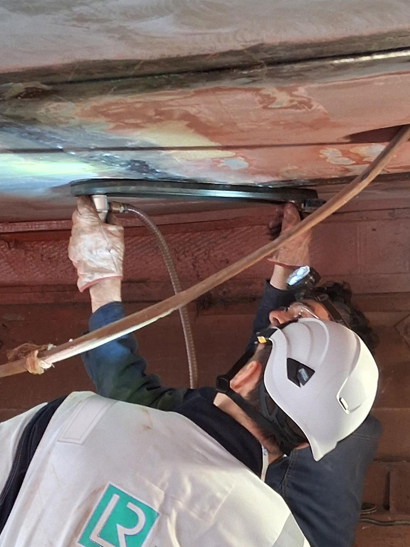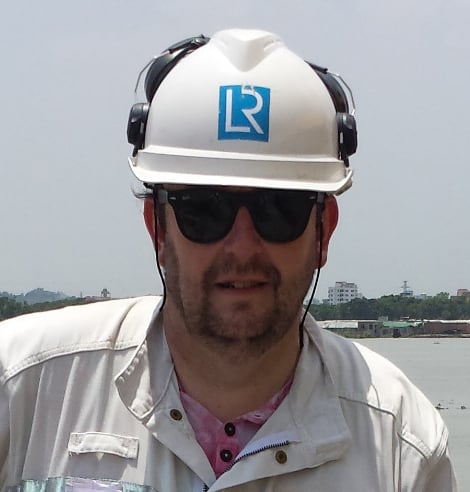London-based Silverstream Technologies has pioneered Air Lubrication System (ALS) technology since 2010. From the company’s early ALS installations to its rapidly expanding orderbook today, LR has been closely engaged in the innovative company’s growth.
It has been a long journey for Silverstream’s Danish founder and CEO, Noah Silberschmidt, previously an investment banker, who set up the business 15 years ago, based in a one-room office in Central London.
However, named as the third fastest growing company in the UK in Financial Times’ 1000 list 2023 and 2024 and one of the top 25 companies in Europe, Noah has overseen a remarkable growth journey. Silverstream now employs more than 130 people at offices in London, Shanghai and Southampton, where it opened a new Global Operations Centre in July last year. Southampton is also home to LR’s Global Technology Centre and the Maritime Engineering School of the University of Southampton, both long-time partners of Silverstream.
Silverstream’s first installation in 2014 was on the 40,000 dwt products tanker, Amalienborg, owned by Dannebrog Rederi and chartered by Shell. This was followed by systems retrofitted to cruise ships across Carnival Corporation & plc cruise lines, with Diamond Princess the first of a total of 9 vessels across the group’s fleets. Ten more are on the way, following the signing of a fleet deal with Carnival Corporation in 2022 to retrofit Silverstream technology to 10 vessels, involving several of the company’s cruise lines.

Independent verification
An essential element in the uptake of the Silverstream® System has been third-party verification of fuel and emissions savings. Since the first installations on the Amalienborg and the Diamond Princess, LR has provided research support and independent verification of system performance as well as developing its own system of ALS-focused third-party oversight of design, installation and operation.
By the end of 2019, Silverstream had 16 systems on order but since then, the take-up has been dramatic, in particular for LNG carriers and container ships. Today, the technology delivers fuel and emissions savings both through retrofits and installation on newbuilds across various shipping segments. Studies are also being conducted to assess the impact of bubbles from ALS on Underwater Radiated Noise (URN), with some promising early results. URN is an issue of mounting concern for ships of the future. With a dedicated I&RD team, Silverstream has been actively involved in research with various industry partners to better understand URN mitigation and how the Silverstream® System can drive progress in this space.
For ships trading in, to, or from Europe, tightening fuel regulations including the EU Emissions Trading System and FuelEU Maritime are focusing more attention on ships’ fuel use and emissions. The regulations, which tighten steadily over time and have a direct cost impact on owners, make investment in technologies such as Silverstream’s ALS an obvious strategy.
From retrofit to newbuild
Today, the company is a market leader in air lubrication business with more than 100 systems in operation and over half of the 500 systems currently on order for ships including cruise ships, LNG carriers, container ships, Ro-Ros, PCTCs and bulk carriers.
In addition, two new carbon dioxide carriers have recently been delivered and a further two vessels are under construction at Dalian in China for the Northern Lights project – an Equinor, Shell and TotalEnergies joint venture. Northern Pioneer and Northern Pathfinder are the first ever ships with ALS on their EEDI certificates.
The types of vessels which have most to gain from ALS technology are big ships with a large flat bottom area. Faster ships gain larger benefits but the uptake among tanker and bulk carrier operators demonstrates that there are gains for these ship types too.
Noah’s leadership of Silverstream so far has been remarkable and could provide a blueprint for the many young marine engineering firms that are currently driving new sustainable technologies. Catching the attention of traditionally conservative marine engineers and ship operations personnel can be a significant challenge but one that the Silverstream team has clearly overcome.
The Silverstream® System is fuel-agnostic and has now clocked up more than a million hours of in-service monitoring. It comprises air compressors and air balancing modules which release a carpet of microbubbles through air release units installed in the ships’ hull. The system is managed through a control and monitoring system and is operated by the ship’s crew. Silverstream has a dedicated team of qualified personnel who are responsible for training crews and also provide lifelong support for the system through the Silverstream® Service.

Partnerships powering efficiency
Carnival Corporation has long been exploring innovative energy-saving technologies, and the Silverstream® System quickly stood out as a promising solution to enhance propulsive efficiency. “Efficiency is of vital importance for us given that propulsion accounts for nearly 50% of onboard energy consumption,” said Chris Millman, VP Corporate Marine Technology, Carnival Corporation.
The decision to retrofit the Diamond Princess was driven by its high-speed itinerary, a hull shape well-suited for optimal ALS performance, and the perfect timing with an upcoming drydocking. This initial retrofit not only provided critical performance data but also yielded several key lessons that are now informing the additional retrofits across the fleet.
The significant data collected on system performance is set to drive future improvements, and the proven benefits of ALS have paved the way for its integration into the cruise operator’s following two newbuild projects.
Earlier this year, Silverstream and Carnival Corporation agreed to install the system on the fourth and fifth Carnival Cruise Line new build Excel-class vessels, representing the third and fourth of Carnival Corporation’s vessels to have the system installed. The 180,000 GT vessels, with a capacity of over 5,000 passengers, will be built at German shipyard Meyer Werft and feature key sustainability technologies to support Carnival Corporation in meeting its decarbonisation goals.
“Beyond ALS, we are committed to reducing emissions across our fleet through a wide range of technologies – from high-efficiency propellers, advanced hull designs, and underwater coatings to on-demand HVAC systems, waste heat recovery, LED lighting, and the adoption of alternative fuels like LNG,” added Millman.
Silverstream’s Key Account Director, Cruise, Luke de Freitas said: “Strong collaboration across all parties has been fundamental to delivering successful retrofits. The teamwork between Lloyd’s Register, Carnival Corporation, shipyards and other partners has enabled us to build on insights from early installations, applying best practices to create impactful retrofit solutions. These efforts have played a crucial role in driving the increased uptake of air lubrication at regular drydocks.”
Third-party validation
 Paul Nichols (pictured right) is LR’s Principal Specialist, Passenger Ship Support Centre, and has been closely involved with Silverstream since the very first installations. For retrofits, where the original ship structure was designed by direct calculation, Nichols stresses the importance of finite element analysis for the installation of ALS to assure sound hull condition.
Paul Nichols (pictured right) is LR’s Principal Specialist, Passenger Ship Support Centre, and has been closely involved with Silverstream since the very first installations. For retrofits, where the original ship structure was designed by direct calculation, Nichols stresses the importance of finite element analysis for the installation of ALS to assure sound hull condition.
Also, onsite expertise in the installation of systems supplied by Silverstream is important. There is a statutory responsibility exercised by the relevant flag authority or their recognised organisation, and the owning company must have an installation team to act on its behalf. Modifications to electricity cabling, piping, and the positioning of key components within the hull may be required in the planning stage to optimise installation of the ALS.
Typically for the three months before work in dock begins, weekly meetings are held, Nichols explains, between Silverstream personnel, class representatives, shipyard personnel and an owner’s superintendency team. There are many complex issues to address – sister ships, for example, are not identical.
“Getting LR involved at an early stage is essential to identify possible risks in advance,” Nichols tells Horizons. “There are many issues to consider: is the owner’s objective to maintain the same speed with less fuel? Or is it to increase speed with the same fuel consumption? In passenger ships, the aim is to raise efficiency, but in other types of ships, there may be different goals.”
In the case of cruise vessels, timing is critical. ALS systems are usually installed during a routine docking (or can be completed at sea) but cruise ships must be ready to resume their itineraries after a docking or refit with accurate timing down to minutes. Meticulous planning is essential because reputational damage – caused by having to delay or cancel a cruise – is out of the question.
Third-party validation is essential for other reasons too, Nichols explains. With many new companies entering the air lubrication industry, it is beneficial to have third-party verification of the system, rather than making decisions based on claims. Having a proven history of installations, relevant experience in the industry along with robust evidence verified by a third party, such as LR, can hugely improve the return on investment for shipowners and charterers.
Since ALS is a relatively new technology for many shipyards, and with the constituent parts coming from other countries, it is essential to establish an effective dialogue with local surveyors in that part of the world, as well as plan approval offices and what is required for class approvals.
Nichols has no doubt that Silverstream’s remarkable development will continue because, he says, the economics are irrefutable. Fuel costs and emission penalties will continue to rise over the next quarter century and ALS technology is certain to become a standard feature of certain ship types, not an optional extra.

